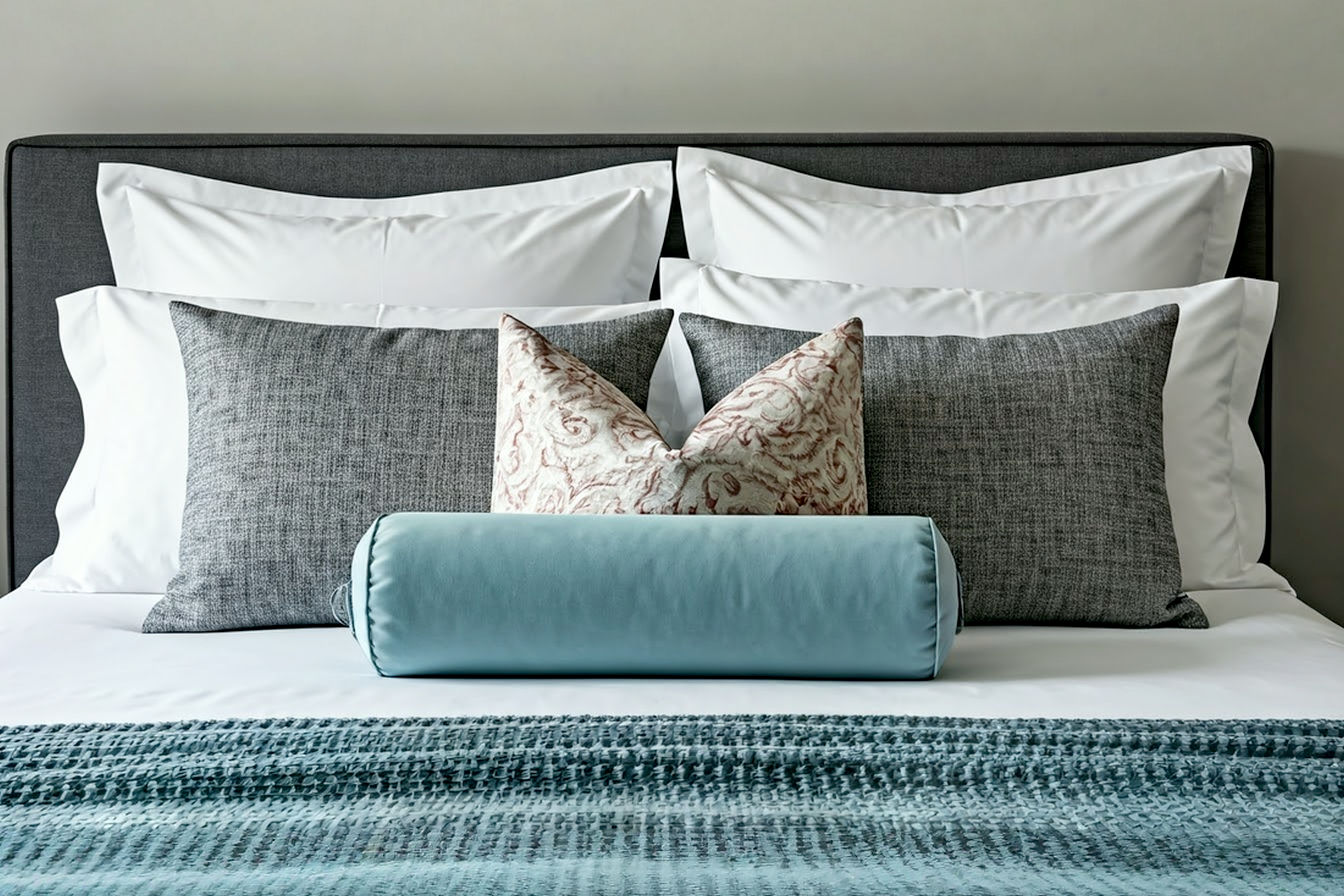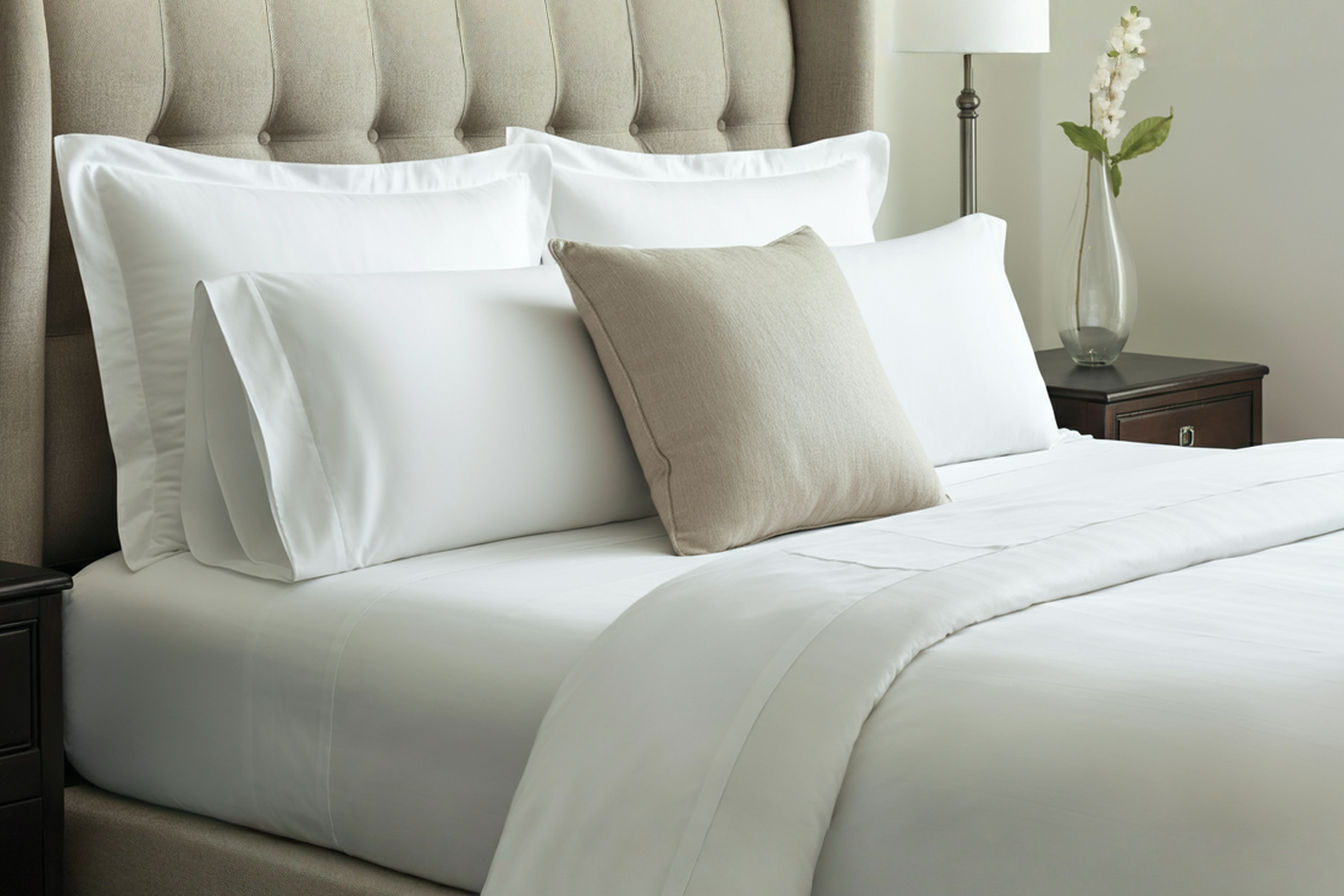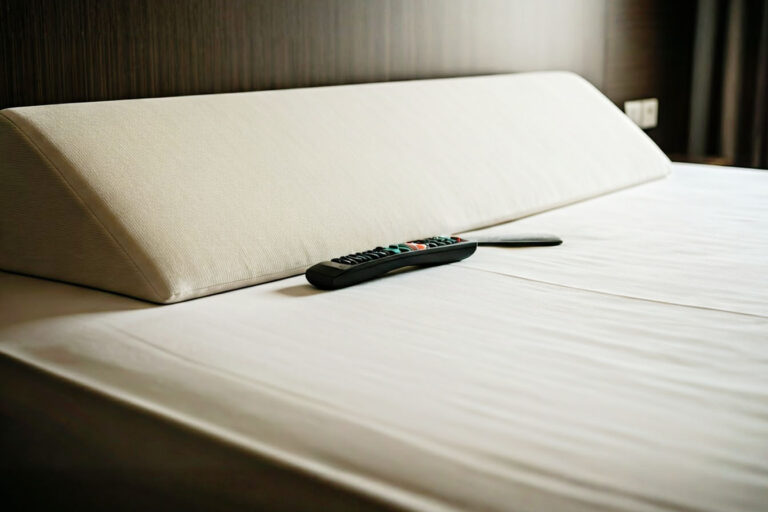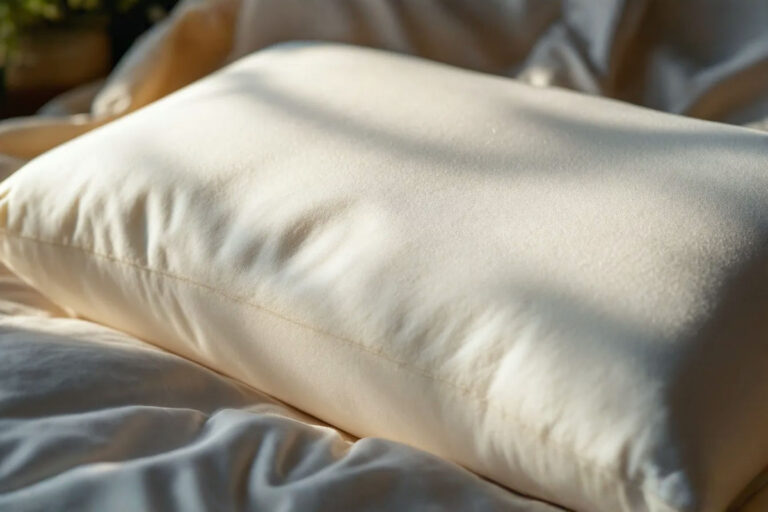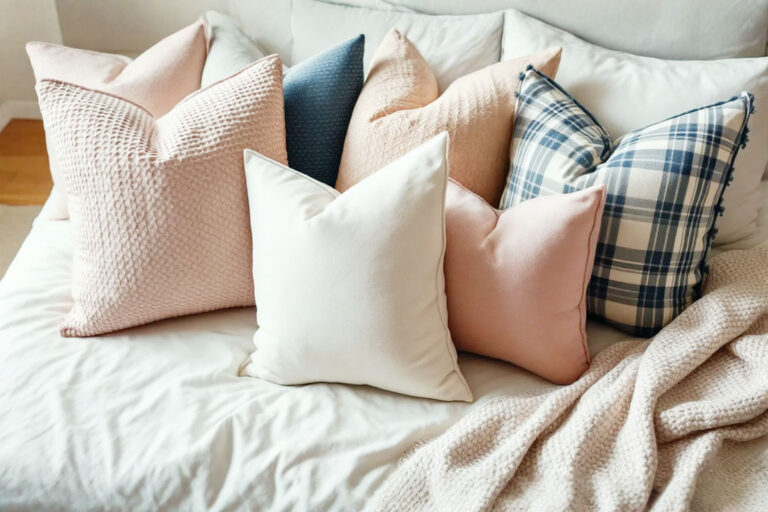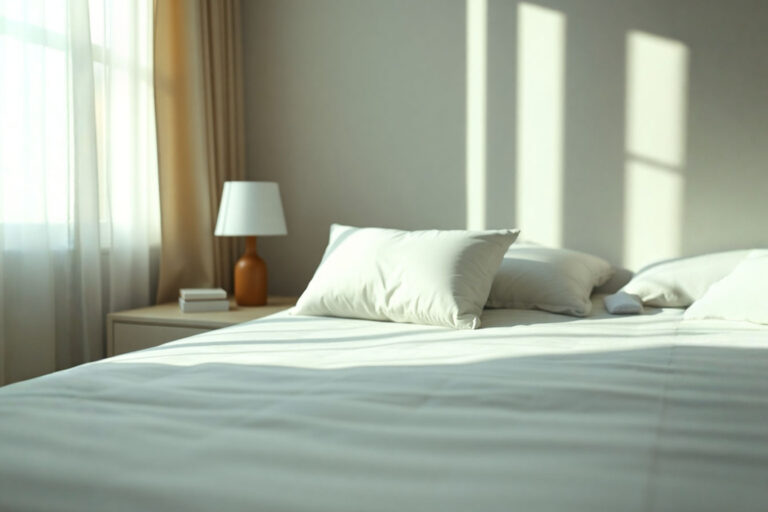Pillow Wedge Headboard Alternative: How to Create Adjustable Support Without Buying New Furniture
Want cozy bed support but not a headboard? A simple solution offers adjustable comfort and style. Find out how to transform your bed today…
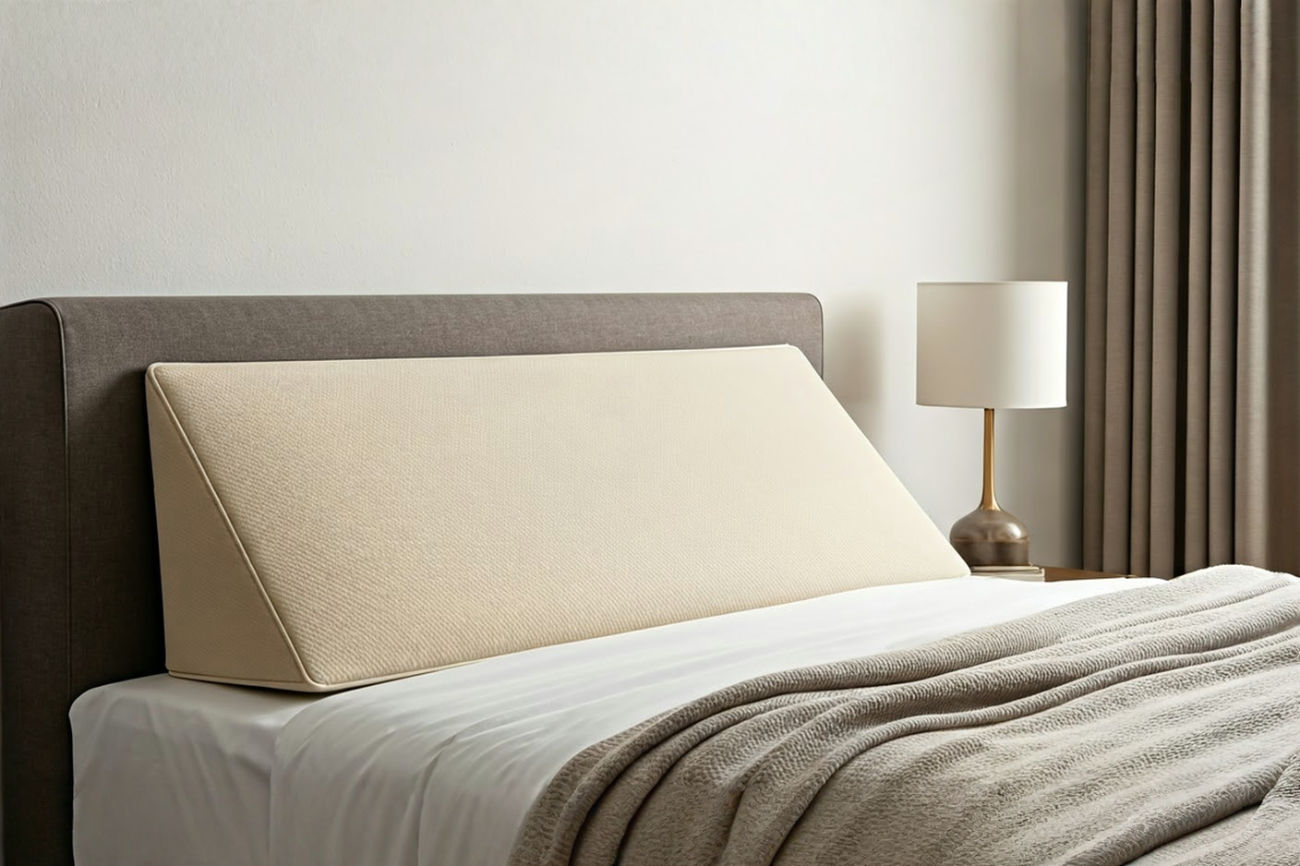
This post may contain affiliate links. If you make a purchase through these links, we may earn a commission at no additional cost to you.
Do you love reading, watching movies, or just lounging comfortably in bed, but find yourself propping up a stack of flimsy pillows that constantly shift and offer zero real support? Maybe you want the functionality of a headboard – that solid, angled backing that lets you sit up properly – but you’re not ready to commit to buying a bulky piece of furniture. Traditional headboards can be expensive, tricky to install, and aren’t always the best fit for renters or those who like to change their bedroom style often.
Fortunately, there’s a fantastic, flexible alternative that provides excellent support without the hassle: the humble pillow wedge. This article will explore how a specially designed wedge pillow can effectively replace a traditional headboard, offering adjustable comfort and ergonomic benefits. We’ll dive into the different types available, their advantages, how to choose the right one, and even how to style your bed to make this alternative look like an intentional design choice. Get ready to transform your bed into a comfortable, supportive haven for relaxation and activities.
Why Consider a Headboard Alternative?
Let’s be honest, traditional headboards aren’t for everyone or every situation. They come with their own set of challenges that might make you look for different solutions.
One major factor is often cost. A well-made headboard, especially one that’s upholstered or made from solid wood, can be a significant investment. If you’re on a tight budget or saving for other things, spending hundreds or even thousands on a headboard might not be a priority.
Another consideration is size and installation. Headboards can be large and heavy, making them difficult to transport and get into your bedroom. Attaching them to your bed frame or mounting them to the wall often requires tools and effort. If you move frequently, taking a headboard with you and reinstalling it each time can be a real pain.
Permanence is also a factor. Once a headboard is installed, it’s a fixed element in your room. If you decide to redecorate or change your style, replacing a headboard is a bigger undertaking than simply swapping out bedding or wall art. Renters, in particular, might be hesitant to drill holes in walls or invest in furniture they can’t easily take with them or that might not fit in a future space.
These drawbacks highlight the appeal of more flexible solutions. Maybe you live in a small apartment where every inch counts, and a bulky headboard feels overwhelming. Perhaps you simply prefer a minimalist look that a large headboard would disrupt. Whatever your reason, exploring non-traditional ways to get that crucial back support for sitting up in bed makes a lot of sense. This is where the pillow wedge steps in, offering a practical and adaptable answer.
Introducing the Pillow Wedge as a Solution
So, what exactly is a pillow wedge, and how can it possibly stand in for a solid headboard? At its core, a pillow wedge is a firm pillow designed with a triangular or angled shape. Unlike standard bed pillows, which are typically soft and flat (great for sleeping, not so great for sitting up), a wedge pillow provides a consistent, supportive incline.
Think of it this way: when you stack regular pillows to sit up, they compress and slump, leaving you with a curved spine and unsupported neck. A wedge pillow, however, maintains its shape and angle, creating a stable backrest. Placed against the wall or the back of your bed frame, the widest part of the triangle sits on the mattress, and the tip points upwards, forming a sturdy, angled surface for you to lean against. This angle is key because it allows you to sit in a more upright, ergonomically sound position compared to slouching against soft pillows.
The primary function of a wedge pillow in this context is to provide a supportive incline for your back and torso. This incline helps distribute your weight evenly, reducing pressure points and allowing your muscles to relax. It effectively mimics the function of a headboard by giving you a solid surface to lean on while you’re sitting up in bed. It’s a simple concept, but incredibly effective for improving comfort and posture when you’re not lying flat.
Compared to standard pillows, the difference in support is significant. Regular pillows are designed for cushioning your head and neck while lying down. Their fill materials are soft and compressible. Wedge pillows, on the other hand, are typically made from denser materials like foam, specifically engineered to provide firm, stable support. This firmness is what allows them to act as a reliable backrest, preventing you from sinking or slouching. They offer a much more functional and comfortable solution for activities like reading, working on a laptop, or watching TV in bed.
Types of Pillow Wedges for Headboard Use
Not all pillow wedges are created equal, and understanding the different types available will help you choose the best one to serve as your headboard alternative. They vary mainly in shape, materials, and size.
Shape Variations
The most common type is the triangular or incline wedge. This is the classic wedge shape, a simple triangle that provides a consistent angle. These are excellent for basic back support and elevating the torso. They come in various angles, typically ranging from 30 to 60 degrees, allowing you to choose the level of recline that feels most comfortable for you. A steeper angle (closer to 60 degrees) will have you sitting more upright, while a shallower angle (around 30 degrees) offers a more reclined position.
Reading pillows, often called “husband pillows,” are another popular option. While not strictly a wedge in the traditional sense, they offer similar back support for sitting up in bed. These pillows typically have a tall backrest and two armrests extending forward. The back is often angled, providing a comfortable lean. The armrests offer extra support and a cozy, enclosed feeling, perfect for curling up with a book. Some reading pillows also include a small headrest.
Contoured wedges are designed with specific curves or indentations to better fit the natural shape of your back or neck. These can offer more targeted support and may be beneficial if you have specific posture or comfort needs. For example, some have a lumbar curve to support the lower back.
Finally, some systems are adjustable or multi-part. These might consist of two or more wedge shapes that can be combined or arranged in different ways to create various angles and levels of support. This offers the most versatility, allowing you to customize your sitting position depending on your activity. You might use one configuration for reading and another for sleeping with slight elevation.
Material Differences
The material inside the pillow wedge is crucial for its firmness, support, and durability.
Foam is the most common filling for supportive wedge pillows. This can be memory foam or polyfoam. Memory foam is known for its ability to conform to your body shape, providing personalized support and pressure relief. It reacts to heat and pressure, molding slightly around you. Polyfoam, or polyurethane foam, comes in various densities. Higher-density polyfoam is firmer and more durable, offering robust support. Lower-density polyfoam is softer. Often, wedge pillows use a combination, perhaps a firm polyfoam base with a layer of softer memory foam on top for comfort. The density of the foam is a key technical specification; it’s measured in pounds per cubic foot (PCF). A higher PCF generally means a firmer, more durable foam. For a supportive headboard alternative, look for wedges with a higher foam density, especially in the base layer, as this provides the necessary structure to prevent slouching.
Fiberfill, similar to the stuffing in regular pillows, is sometimes used, but it’s generally less supportive and more prone to flattening over time compared to foam. While softer, it won’t provide the firm, consistent angle needed to truly act as a headboard alternative.
Some wedges use combination materials, layering different types of foam or combining foam with fiberfill to achieve a balance of support and softness.
The cover materials are also important for comfort, breathability, and ease of cleaning. Common options include cotton, bamboo fabric, polyester blends, or microsuede. Cotton and bamboo are often preferred for their breathability and natural feel. Polyester blends are durable and often wrinkle-resistant. Look for covers that are removable and machine washable, as this makes maintenance much easier. Some covers also have anti-slip properties to help keep the wedge in place against the wall or bed frame.
Size Considerations
Choosing the right size wedge pillow is important for both comfort and aesthetics when using it as a headboard alternative.
Ideally, you want a wedge that’s wide enough to span most of your bed. Wedges are often sold in sizes corresponding to standard bed sizes: Twin, Queen, and King. A Queen-sized wedge is typically around 60 inches wide, while a King-sized one is about 76 inches wide. Matching the wedge width to your mattress width creates a more cohesive look and ensures you have consistent support across the back of your bed.
The height and angle of the wedge also matter. The height determines how high up your back the support extends when you’re sitting up. A taller wedge offers support for your upper back and shoulders, while a shorter one might only support your lower or mid-back. The angle, as mentioned before, dictates how upright or reclined you’ll be. Consider how you plan to use the wedge most often – a steeper angle is better for active tasks like working on a laptop, while a more reclined angle might be preferable for relaxed reading or watching TV.
Thinking about these variations in shape, material, and size will help you narrow down the options and find a pillow wedge that provides the specific type of support and comfort you need to replace a traditional headboard effectively.
Benefits of Using a Pillow Wedge for Bed Support
Beyond just being a headboard alternative, using a pillow wedge for bed support offers several tangible benefits, particularly related to ergonomics and comfort.
Ergonomic Support
One of the primary advantages is the ergonomic support it provides when you’re sitting up in bed. Sitting against a flat wall or slumping against soft pillows forces your spine into a curved, unnatural position. This can lead to poor posture, muscle strain, and discomfort over time.
A wedge pillow, with its angled surface, helps you maintain a more natural, upright posture. It supports the natural curve of your spine, from your lower back all the way up to your shoulders, depending on the wedge’s height. This proper spinal alignment is crucial for reducing strain on your back and neck muscles. When your spine is properly supported, the muscles don’t have to work as hard to keep you upright, which means less fatigue and fewer aches.
Think of it like sitting in a well-designed chair with good lumbar support. The wedge provides that same kind of targeted support, but in your bed. By providing a stable, angled surface to lean against, it encourages you to sit with your shoulders back and your head aligned with your spine, significantly reducing neck and back strain. This is especially beneficial if you spend a lot of time reading, working, or watching TV in bed. The consistent support allows you to relax more fully without worrying about discomfort creeping in.
Health Benefits (Secondary but Relevant)
While primarily a comfort item, using a wedge pillow can also offer some secondary health benefits due to the elevated position it provides.
One common use for wedge pillows is to help alleviate symptoms of acid reflux or GERD (Gastroesophageal Reflux Disease). When you lie flat, stomach acid can more easily flow back up into the esophagus, causing heartburn and discomfort. Elevating your upper body, even slightly, uses gravity to help keep stomach contents where they belong. Medical professionals often recommend sleeping with the upper body elevated for individuals with these conditions. A wedge pillow provides a convenient way to achieve this elevation while still allowing you to rest comfortably. The recommended elevation for GERD relief is typically 6-8 inches, which many standard wedge pillows provide.
Similarly, elevating your head and chest can improve breathing for some individuals. If you suffer from sinus congestion or snoring, sleeping or resting in a slightly elevated position can help open up airways. Gravity assists in draining nasal passages and can prevent the tongue from falling back and obstructing the airway, which is a common cause of snoring. While not a cure, it can offer noticeable relief for mild to moderate issues.
For individuals recovering from certain surgeries, particularly those involving the chest or abdomen, a wedge pillow can provide comfortable support and help maintain a required elevated position during recovery. It can also make getting in and out of bed easier.
Comfort and Versatility
Beyond the functional benefits, using a pillow wedge simply makes your bed a more comfortable place to be when you’re not sleeping. It instantly transforms your bed into a cozy spot for activities.
It’s perfect for creating a dedicated reading nook. Instead of stacking pillows precariously, you have a stable, comfortable backrest that lets you settle in for hours with a good book. The same applies to working on a laptop, scrolling on your tablet, or watching your favorite show. The wedge provides a solid foundation that allows you to relax and focus on your activity.
Another major plus is its ease of adjustment and removal. Unlike a fixed headboard, you can easily reposition a wedge pillow to change your angle or move it entirely out of the way when you want to sleep flat. This flexibility is a key advantage.
Furthermore, a wedge pillow isn’t confined to your bed. You can easily move it to the floor for comfortable seating during movie night, use it on a sofa for extra back support, or even take it with you when traveling (though larger ones might be cumbersome). This versatility adds to its value as a piece of functional home decor.
By providing superior ergonomic support, potential health benefits, and unmatched comfort and versatility, a pillow wedge proves to be a highly effective and beneficial alternative to a traditional headboard.
How to Choose the Right Pillow Wedge
Selecting the perfect pillow wedge to serve as your headboard alternative requires considering your specific needs and evaluating key features. Not every wedge is suitable for this purpose; you need one that offers adequate support and fits your space.
Assessing Your Needs
Start by thinking about how you primarily intend to use the wedge. Is it mainly for reading and lounging, where comfort and a specific angle are paramount? Or are you also hoping for potential health benefits like acid reflux relief, which might require a specific elevation? Understanding your main purpose will guide your choices regarding shape, size, and angle.
Consider your desired firmness and support level. Do you prefer a very firm, almost rigid backrest, or something with a bit more give? This will influence the type and density of the foam you should look for. If you need significant support to prevent slouching, a higher-density foam is usually better.
Finally, consider your budget. Pillow wedges range in price depending on size, materials, and brand. Knowing how much you’re willing to spend will help you narrow down options. While it might be tempting to go for the cheapest option, remember that a higher-quality wedge made from durable materials will likely offer better support and last longer, making it a better investment in the long run.
Key Factors to Evaluate
Once you know your needs, evaluate potential pillow wedges based on these key factors:
The size and dimensions are crucial. As mentioned earlier, consider the width of your bed (Twin, Queen, King) and try to find a wedge that matches or is close to that width for a seamless look and consistent support. Also, look at the height of the wedge. How high up your back do you want the support to extend? Measure from your mattress upwards to get an idea of the height you need for comfortable back and shoulder support while sitting.
The angle of incline is another critical factor. Common angles include 30°, 45°, and 60°. A 30° angle provides a gentle slope, good for slight elevation or a more reclined position. A 45° angle is a popular choice for reading and lounging, offering a good balance of upright support and relaxation. A 60° angle puts you in a more upright position, better suited for working on a laptop or tasks where you need to be more alert. Some adjustable wedges offer multiple angles. Think about the activities you’ll be doing most often to determine the ideal angle.
The material quality and durability directly impact the wedge’s performance and lifespan. For a supportive headboard alternative, look for wedges made from high-density foam. Memory foam offers contouring comfort, while a firm polyfoam base provides essential structure. Check the product specifications for foam density (often listed in PCF). Higher numbers generally indicate firmer, more durable foam. Read reviews to see what other users say about the wedge’s ability to maintain its shape and firmness over time.
Ease of cleaning is a practical consideration. Look for wedges with removable covers that are machine washable. This makes it simple to keep your wedge fresh and hygienic. Some covers are also stain-resistant or have anti-microbial properties.
Finally, check reviews and brand reputation. What do other buyers say about the wedge’s comfort, support, and durability? Has the brand been around for a while and do they specialize in sleep or comfort products? Reputable brands often use higher-quality materials and stand behind their products.
Trying Before Buying (if possible)
If you have the opportunity, such as at a home goods store or a friend’s house, trying out a wedge pillow before purchasing is highly recommended. Comfort is subjective, and what feels supportive to one person might feel too hard or too soft to another. Sitting against a wedge allows you to feel the angle, the firmness, and how it supports your back firsthand. If buying online, check the return policy in case the wedge doesn’t meet your expectations once you receive it.
By carefully considering your needs and evaluating these key factors, you can select a pillow wedge that provides excellent support and functions effectively as a comfortable and practical headboard alternative.
Setting Up Your Pillow Wedge Headboard Alternative
Once you’ve chosen the perfect pillow wedge, setting it up to function as your headboard alternative is straightforward. The beauty of this solution is its simplicity and flexibility.
The most common way to use a wedge as a headboard is to place it directly against the wall at the head of your bed. The weight of the mattress and the wedge itself, combined with the wall behind it, usually provides enough stability to keep it in place when you lean against it. Ensure the widest, base part of the wedge is resting firmly on the mattress, pushed back against the wall.
If your bed isn’t against a wall, you can still use a wedge, although it might require a bit more effort to keep it stable. You can place it against the back of your bed frame, if it has a solid back. For frames without a solid back, you might find the wedge tends to slide. In this case, using a non-slip mat placed between the wedge and the mattress can help significantly. These are similar to the mats used under rugs to prevent slipping and provide extra grip. Simple rubber or silicone mats work well. Alternatively, some people find that placing a heavy blanket or duvet cover tucked tightly under the mattress lip in front of the wedge can also help anchor it.
You can also layer the wedge with other pillows for added comfort and support. A smaller, softer pillow placed at the top of the wedge can provide cushioning for your neck and head. You can also place regular pillows in front of the wedge for extra lumbar support or simply for decorative purposes. Experiment with different arrangements to find what feels most comfortable for you.
Integrating the wedge with your existing bedding and decor is easy. Since the wedge sits on top of your mattress, it doesn’t interfere with your sheets, blankets, or duvet. You can simply arrange your existing bedding around it. The wedge itself can be covered with a decorative slipcover (more on that later) or simply blend in with your existing pillows. The goal is to make it look like an intentional part of your bed setup, not just an afterthought.
Compared to the often complex process of assembling and attaching a traditional headboard, setting up a pillow wedge is remarkably simple. You can have your comfortable, supportive “headboard” in place in just a few minutes, ready for you to relax and enjoy.
Styling Your Bed with a Pillow Wedge
One concern people sometimes have about using a pillow wedge as a headboard alternative is whether it will look good. The answer is a resounding yes! With a little thought, you can style your bed to make the wedge look like a deliberate and attractive design element.
The key is to make it look intentional and stylish, not just like a functional item. The easiest way to do this is by choosing a wedge with a cover that complements your bedroom decor. Many wedge pillows come with neutral-colored covers (white, grey, beige), which can easily blend in. However, some brands offer covers in various colors and textures. You can also purchase separate decorative covers specifically designed for wedge pillows.
Consider the color and texture of the wedge cover in relation to your bedding and the overall style of your room. If you have a minimalist room, a sleek, solid-colored cover might be best. For a bohemian look, you could choose a wedge with a textured cover or layer patterned throw pillows in front of it.
Adding throw pillows and blankets is a fantastic way to integrate the wedge and create a layered, inviting look. Place smaller decorative pillows in front of the wedge. You can mix and match sizes, shapes, colors, and textures. A cozy throw blanket draped over the foot of the bed or folded neatly on top of the duvet can also add to the visual appeal and make the bed feel more complete, even without a traditional headboard.
The goal is to create a cohesive look that feels finished and stylish. Think of the wedge as the backdrop for your pillow arrangement. By carefully selecting the wedge cover and layering other decorative elements, you can create a focal point at the head of your bed that is both functional and aesthetically pleasing.
Here are a few styling ideas:
- Minimalist: Use a wedge with a crisp white or light grey cover. Layer with one or two solid-colored throw pillows in a complementary neutral shade. Keep bedding simple and uncluttered.
- Bohemian: Choose a wedge cover with a natural texture, like linen or cotton. Layer with an assortment of throw pillows in various patterns (florals, geometrics, global prints) and textures (knits, macrame). Add a colorful throw blanket.
- Modern: Opt for a wedge with a smooth, solid-colored cover in a bold or jewel tone that contrasts with your wall color. Use graphic or geometric-patterned throw pillows. Keep lines clean and simple.
By treating the pillow wedge as a design opportunity rather than just a functional necessity, you can easily style your bed to create a beautiful and comfortable space that doesn’t require a traditional headboard.
DIY Enhancements and Customization
While a standard pillow wedge works perfectly well on its own, you can easily enhance and customize it to better suit your style and needs. A little bit of DIY can go a long way in making your wedge truly feel like a personalized headboard alternative.
One of the simplest and most effective customizations is creating a fabric slipcover. If you can’t find a wedge cover in the color or pattern you want, or if you just want to change the look seasonally, sewing a simple slipcover is a great option. You don’t need to be an expert seamstress; a basic envelope style or a zippered cover is relatively easy to make with just some fabric, a sewing machine, and basic measurements of your wedge. This allows you to perfectly match your wedge to your bedding or room decor. You can choose from a vast array of upholstery fabrics or even durable cottons.
For a more decorative touch, you could consider adding buttons or tufting to your slipcover. This technique involves sewing through the pillow and cover at specific points, often with buttons on the front, to create dimples and a more structured, upholstered look. This can give your wedge a more sophisticated and finished appearance, similar to a traditional upholstered headboard. You can find tutorials online for how to do basic tufting on pillows.
If you find your wedge still slides a bit or you want a more integrated look, you could consider building a simple frame or support structure. This doesn’t have to be complex woodworking. It could be as simple as a low platform built from plywood that the wedge sits on, or a cleat system mounted to the wall that the wedge slots into. These ideas are more involved but can provide extra stability and make the wedge feel more like a permanent fixture. However, the beauty of the wedge is its simplicity, so don’t feel pressured to build something elaborate unless you want to.
You can also combine multiple wedges or pillows to create a custom support system. For instance, you might use a large, firm wedge as the main backrest and then place a smaller, softer wedge or a lumbar pillow in front of it for targeted support. Layering different pillows allows you to fine-tune the angle and firmness to your exact preference.
DIY enhancements offer a fantastic way to personalize your pillow wedge headboard alternative. Whether it’s a simple slipcover or a more involved support structure, these customizations can make your wedge even more functional and stylish, perfectly tailored to your taste and comfort needs.
Maintenance and Care for Your Pillow Wedge
Like any bedding item, your pillow wedge will benefit from regular maintenance and care to keep it fresh, clean, and supportive for as long as possible. Proper care helps extend its lifespan and ensures it continues to function effectively as your headboard alternative.
The most important aspect of care usually involves the cover. Most quality wedge pillows come with a removable cover, which is designed to be cleaned. Always follow the manufacturer’s instructions for washing the cover. Typically, this involves unzipping and removing the cover and machine washing it on a gentle cycle with mild detergent. Tumble drying on a low heat setting or air drying is usually recommended to prevent shrinkage or damage. Washing the cover regularly (as often as you wash your sheets) helps remove dust, sweat, and oils, keeping your wedge hygienic.
Cleaning the foam or fill inside the wedge is a bit different, as these materials usually can’t be submerged in water. For foam wedges, spot cleaning is the recommended method. If there’s a spill or a stain, use a clean cloth dampened with a small amount of mild soap and water to gently blot the affected area. Avoid saturating the foam, as it can be difficult to dry completely and could lead to mold or mildew. After spot cleaning, allow the foam to air dry completely before putting the cover back on.
Regularly airing out your pillow wedge is also a good practice. Foam can sometimes retain odors over time. Removing the cover and letting the foam air out in a well-ventilated area for a few hours can help dissipate any smells. Avoid direct sunlight, as prolonged exposure can damage some types of foam.
When you’re not using your wedge, or if you need to store it temporarily, find a clean, dry place. Some wedges come with storage bags. If not, you can use a large dust bag or a clean sheet to protect it from dust and dirt. Store it flat if possible, or on its side, to help maintain its shape. Avoid storing heavy items on top of it, which could compress the foam permanently.
The longevity of your pillow wedge depends on the quality of its materials and how well you care for it. A high-quality foam wedge, properly maintained, can last for several years, providing consistent support. However, over time, even the best foam can start to lose its firmness and supportiveness. If you notice your wedge is no longer providing adequate support, is significantly flattened, or has persistent odors that won’t go away, it might be time to consider replacement. Think of it like replacing a mattress or a well-worn pillow – eventually, materials break down and lose their ability to support you properly.
By incorporating these simple maintenance and care practices, you can keep your pillow wedge clean, fresh, and supportive, ensuring it remains an effective and comfortable headboard alternative for years to come.
Pillow Wedges vs. Other Headboard Alternatives
While pillow wedges are a fantastic option, they aren’t the only alternative to a traditional headboard. It’s helpful to briefly compare them to other popular non-traditional solutions to understand their unique advantages.
Some people opt for wall-mounted panels or upholstered tiles. These are attached directly to the wall behind the bed and can create a similar visual effect to an upholstered headboard. They offer a more permanent solution than a wedge and can be customized in terms of fabric and layout. However, they require installation (drilling into the wall) and are not easily moved or changed.
Tapestries or large pieces of fabric art hung on the wall behind the bed can also serve as a decorative headboard alternative. They add color, pattern, and texture to the space and are relatively easy to install and change. However, they offer no physical support for sitting up in bed.
A simple and budget-friendly option is to paint a “headboard” directly onto the wall. This involves painting a shape or design behind the bed to mimic the look of a headboard. It’s purely decorative and provides no physical support.
Other alternatives include using screens or room dividers placed behind the bed, stacking decorative pillows against the wall (though this offers limited support), or even using a bookshelf or console table placed at the head of the bed (which can provide a surface but isn’t comfortable to lean against).
The key advantage of the pillow wedge compared to most of these alternatives is its combination of physical support and flexibility. While options like wall panels offer support, they lack portability and are less adaptable. Decorative alternatives like tapestries or painted shapes offer visual appeal but no ergonomic benefit.
The pillow wedge uniquely provides a comfortable, angled surface to lean against for reading, working, or lounging, directly addressing the functional need that often drives the desire for a headboard. It’s also highly portable, requires no installation (unless you choose to add a support structure), and can be easily adjusted or removed. This blend of portability, ergonomic support, and ease of use sets the pillow wedge apart as a highly practical and versatile headboard alternative.
Conclusion
Choosing a pillow wedge as an alternative to a traditional headboard is a smart, practical, and comfortable decision. It offers a flexible solution for anyone who wants supportive backrest for sitting up in bed without the cost, bulk, and permanence of a conventional headboard.
Throughout this article, we’ve seen how pillow wedges, with their various shapes, materials, and sizes, can effectively provide the angled support needed for reading, working, or simply relaxing in bed. We’ve explored the significant ergonomic benefits, such as improved spinal alignment and reduced strain, as well as potential secondary health advantages like relief from acid reflux and improved breathing.
We’ve also discussed how to choose the right wedge based on your needs, evaluating factors like size, angle, and material quality. Setting up your wedge is simple, and with a little creativity, you can easily style your bed to make the wedge look like an intentional and attractive part of your bedroom decor. For those who enjoy personalizing their space, DIY enhancements like custom slipcovers offer further opportunities to tailor the wedge to your taste.
Ultimately, a pillow wedge is more than just a pillow; it’s a versatile piece of furniture that enhances your comfort and transforms your bed into a more functional space. It proves that you don’t need to buy new furniture to create the adjustable support you desire. Embrace the flexibility and comfort a pillow wedge offers, and enjoy your newly supportive and stylish bed setup.

